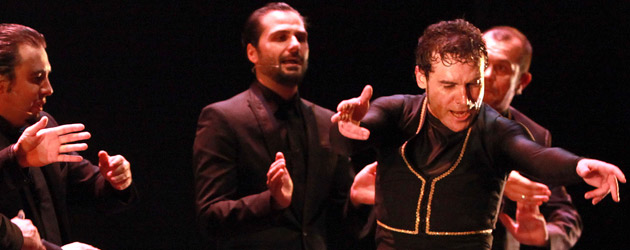Text: Estela Zatania
Photos: Ana Palma
18th FESTIVAL DE JEREZ
Andrés Peña «Órdago a la grande»
Manuel de la Fragua, Andrés de Jerez
Monday, March 3rd, 2014. Jerez de la Frontera
Special 18th Festival de Jerez – All the information
ANDRÉS PEÑA “ÓRDAGO A LA GRANDE”
Teatro Villamarta, 9:00pm
Dance: Andrés Peña. Cante: Miguel Ángel Soto “El Londro”, Miguel Lavi, David Carpio, José Anillo. Guitarra: Jesús Guerrero. Percussion: Israel Mera. Original idea: Andrés Peña, Pilar Ogalla.
If good singing and guitar have always been abundant in Jerez de la Frontera, flamenco dance never quite took root in this city. The fingers of one hand are more than enough to count the current stars, but without a doubt, one of those fingers corresponds to Andrés Peña, although his name might not be as familiar as that of others.
His generation strides the end of the era of the most traditional flamenco, and the beginning of the modern era of conceptual works or those based on modern dance. He is a serious and intense dancer, stylistically strong and compact, and he makes no concessions.
That uncompromising seriousness last night translated into the beginning of a path little-traveled until now by Andrés Peña. This dancer who had long defended conventional flamenco dance, nearly always with his partner Pilar Ogalla, seemed to be saying “ok, now it’s my turn to conceptualize”. Being an admirable artist, and having had the good taste to surround himself with four excellent singers, Miguel Lavi, El Londro, David Carpio and José Anillo, and the fine guitar of Jesús Guerrero, we were all ears and eyes for this show.
The clichés of black on black, black costumes and empty chairs as props have become the new “pure” flamenco, just as outmoded as the previous kind. Andrés has arrived late to this party now in its last throes, and where he is an uneasy guest. An arrangement of vidalita choreographed by Eva Yerbabuena comes off as contrived, until a guitar sounds por bulerías, Peña’s comfort zone. Siguiriyas with chairs…Miguel Lavi must keep a chair from tipping over while putting his energy into the cante. Alegrías as a vocal piece, ending with bulerías de Cádiz, the singers in profile and face to face, and the absence of light and color shows no sign of letting up.
There is a great deal of putting on and removing of shoes that seems like another attempt to “do something different”, or maybe it’s me who was unable to catch the meaning. Fandango por soleá for Andrés’ dance, tangos, caña…this is the year of caña in the Festival…abandolao… A lyrical guitar solo melts into soleá. The singers demonstrate their knowledge of this basic form, and then surround the dancer like high priests of compás while Andrés confesses por bulerías. This is when sparks finally fly, and we see this fine dancer doing what he does best: dance flamenco.
All too soon we are returned to the conceptual realm for the ending when Andrés Peña hangs a pair of shoes on a string that descends from above, lies on the floor and sings something barely audible, without music or rhythm, while the shoes are slowly raised heavenward.
MANUEL DE LA FRAGUA, ANDRÉS DE JEREZ
Palacio Villavicencio, 7:00pm
At seven in the evening at the Palacio Villavicencio, we attended a recital shared by two little-known but interesting Jerez singers. Young Manuel de la Fragua, one of the grandsons of Tío Juane (a blacksmith, hence the reference to “fragua”), came to demonstrate his great love and respect for the most classic forms. His style is that prodigious mix of the San Miguel neighborhood colored with the influence of Antonio Mairena. To the sound of a hammer and anvil, he began with martinete, and then the solid guitar of Domingo Rubichi accompanied him for soleá, fandangos and bulerías of San Miguel to wind up, with a few dance steps included.
In the second part, we were able to enjoy the anarchic instinctive veteran Andrés de Jerez, who last year surprised everyone with his singing at the Sala Paúl, just as we were surprised by the excellent guitar accompaniment of Carlos Grilo who again backed up the singer last night. Tientos, not as an excuse to sing tangos but as an independent form, soleá with Agujetas-like intensity, siguiriyas with just the right lack of control that so favors this form, and fandangos to end.
Manuel de la Fragua
Andrés Peña «Ordago a la grande»
